 |
 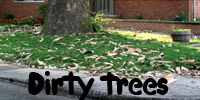 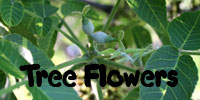 |
Welcome
to bobklips.com, the website of Bob Klips, a plant enthusiast living in
Columbus, Ohio. Tree of Heaven Flowers. OSU at Marion June 12, 2008 Not exactly a popular
tree, Ailanthus altissima
(tree-of-heaven, family Simaroubaceae) is a very fast growing weed of
roadsides, open woods and edges of woods. It's flowering now. Big
whoop.
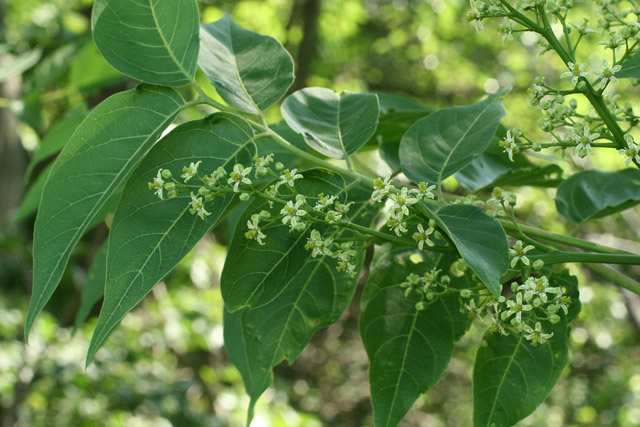 Tree-of-heaven (Ailanthis altissima), June 12, 2008, OSU at Marion. The breeding system of
this plant is
described as "polygamous" defined as bearing partly perfect, and partly
unisexual flowers. Last year as part of the "tree flowers" project, I
tried to photograph this species at a location in Columbus where, as
luck would have it, all the trees were staminate (male)! This time and
place, however, the plants are more cooperative, bearing what looks
like perfect (bisexual) flowers. Here's a closeup.
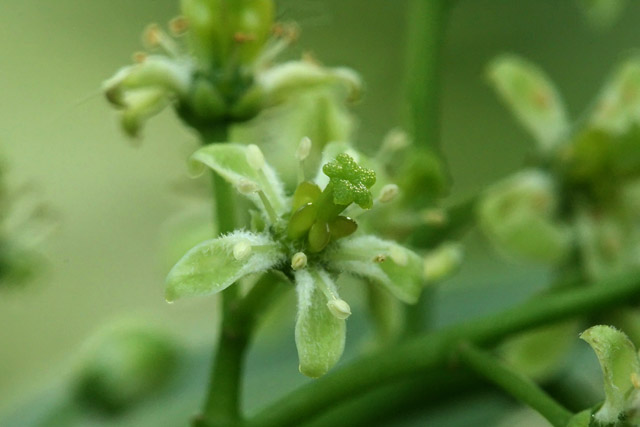 Ailanthus altissima flower, June 12, 2008, Marion County, OH. But how on earth will
flowers like these
--having a deeply 5-parted ovary --develop into fruits like the ones
shown below (taken at the same locality late least year).
Tree-of-heaven produces winged one-seeded fruits, called
samaras,
as do ash, maple, elm, and tulip-tree. It doesn't seem possible. We'll
have to wait and see!
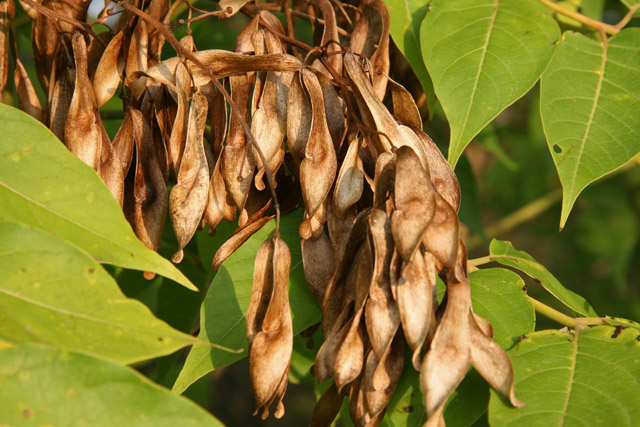 Alanthus (tree-of-heaven) fruits, OSU at Marion, October 17, 2007. Catchfly, and an Uncaught Fly Caledonia, Marion County, OH. June 12, 2008 Caledonia Woods is a
32.8 acre lowland
forest owned and managed as a nature preserve by the Marion County
Prairie Parks Commission. It is bordered by the Olentangy (Whetstone)
River. An active set of RR tracks runs through it. There is a small
barren area that was once used as a disposal site for dredge
spoils. It is occupied by alien weeds and native early succession
pioneer trees. One of the weeds is a delicate member of the pink family
(Caryophyllaceae) called "night-flowering catchfly" (Silene
noctiflora). It is presently in fruit, not flower. The fruit
is a capsule that opens by teeth (suggestive of a moss capsule).
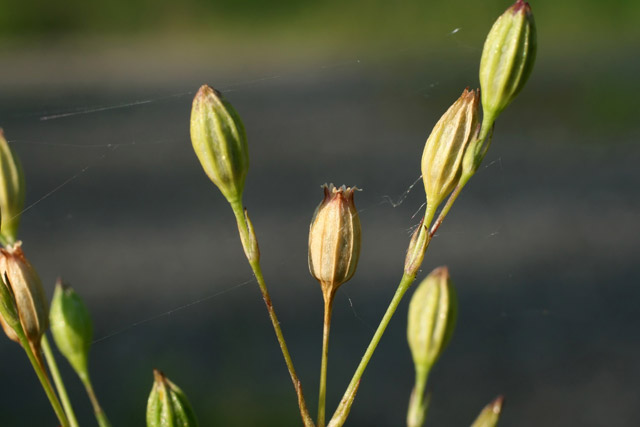 Night-flowering catchfly (Silene noctiflora) fruits, Caledonia, OH, June 12, 2008. The reason for the odd name is that the stem has sticky parts along its length. In a couple of places about an inch long, it's tacky like flypaper. This seems more likely to be an adaptation to discourage ants rather than flies, since ants are more likey to try and crawl up stems than are flies. Flies fly. 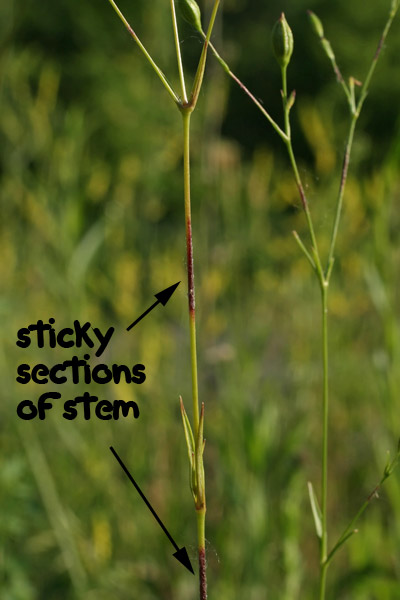 Night-flowering
catchfly (Silene noctiflora) stem, June 12, 2008,
Caledonia, Ohio.
Nearby, field bindweed, Convolvulus arvensis (family Convolvulaceae) is merrily being visited by a syrphid fly. These look like little bees, but they're flies. Flies are easy to recognize if you can get close enough. They have only one pair of wings, the front pair. The hind wing are modified into little knob-like balancing organs called "halteres." 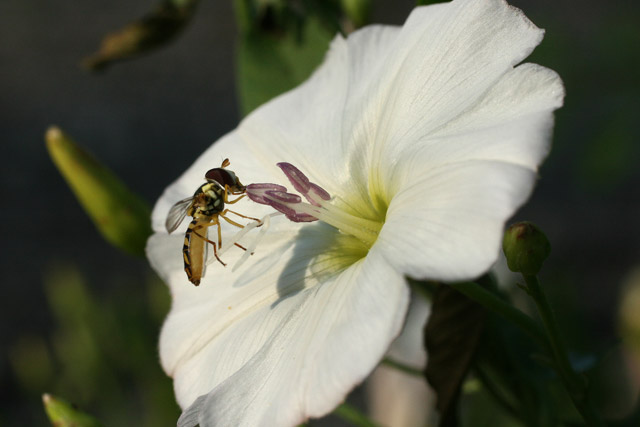 Field bindweed (Convolvulus arvensis) being visited by a syrphid fly. Caledonia, Marion County, OH, June 12, 2008. Does the syrphid fly
pollinate the
bindweed? It isn't apparent from this observation. The fly certainly
grabbed on to the pollen-receptive stigma, as shown in this "actual
pixels" blow-up from the photo above. But there doesn't seem to
be any pollen accumulated on the fly's body
that could transfer
to the stigmas.
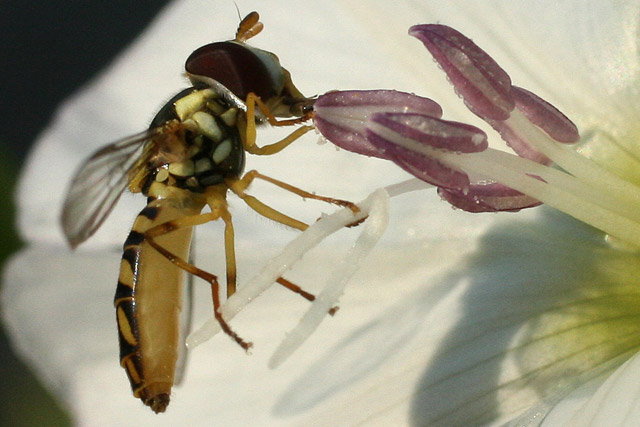 Syrphid fly grasping stigmas of bindweed, Caledonia, Marion County, OH, June 12, 2008. It's also hard to see
exactly what the fly
is getting from the flower. Some flies, including houseflies and
apparently this one,
have "sponging-sucking" mouthparts, shown below in an enlargement of
another picture. We can see it is trained on the pollen-bearing anther.
Does this fly ingest pollen? It doesn't seem possible with this type of
feeding
apparatus. But what other nutrition is there for the fly to suck up?
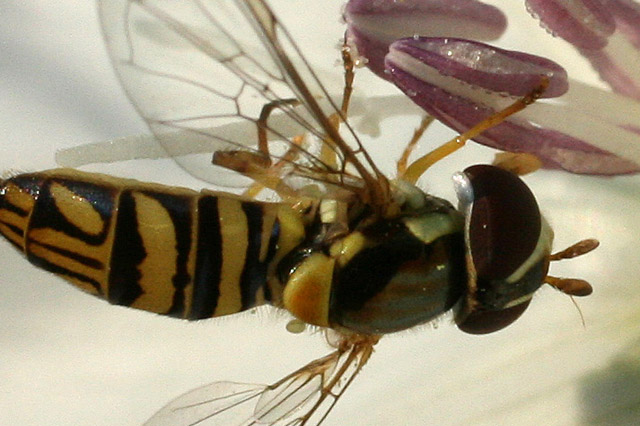 Syrphid fly sponging-sucking who knows what from bindweed anthers, Caledonia, Marion County, OH, June 12, 2008 Arghhh! Hemlock! Columbus OH Roadside June 7, 2008 Many central Ohio
roads are now flanked by a dense monoculture of our most poisonous
poisonous plant, poison hemlock, Conium maculatum.
(Danger, poison!)
 Poison hemlock (Conium maculatum) along Columbus roadside, June 7, 2007. This stuff is really
toxic. The
active ingedient, Conine, is a neurotoxin that blocks an acetylcholine
receptor on the neuromuscular junctions of peripheral
nerves, causing an ascending muscular paralysis that
eventually
stills the muscles that enable breathing. The only way to avoid death
is to go on artificial ventilation for a few days, until the
effects subside. Very small amounts can be lethal! Arghh!
Poison hemlock is famous for having been the self-inflicted method by which the Greek scholar Socrates was executed in 399. His last words, spoken to a friend who tried but wasn't able to convince him to escape was "Crito, we owe a cock to Asclepias. Please, don't forget to pay the debt." Asclepius was the Greek god for curing illness, but Socrates wasn't hoping for a cure from the hemlock poision. Instead he was regarding death itself as as a cure. A cure for life I guess. Bleak.  The Death of Socrates, by Jacques-Louis David (1787). Conium
is a very typical member of
the Apiaceae --a biennial with compound leaves that have
sheathing bases, and tiny white flowers produced in compound
umbels. As such it's fairly similar to another abundant weed, the
harmless Queen Anne's lace (Daucus
carota), which is also called wild
carrot because it actually is
wild carrot. Here are some identification tips for the poison hemlock I
examined today, with comparison to the friendly Queen Anne's lace.
Stages Pond State Nature Preserve, Pickaway County,
OH, July 26, 2003.Poison hemlock is much bigger than Queen Anne's lace, and begins blooming several weeks earlier.   Two white flowered
umbellifers in Columbus, OH.
Left: poison hemlock,
June 7, 2008. Right: Queen Anne's Lace, July 9, 2006.
An umbel is an
inflorescence (flower
cluster) that has stalked flowers that are all attached at one point.
Most members of the Apiaceae, moreover, bear compound umbels, wherein
simple "umbellets" are jointly connected to a single point
on the main flowering axis (the peduncle). There might be a
whorl
of small leaf-like bracts --the involucre --sitting just
beneath
the connecting point of the stalks of the umbellets The
involucre is a major distinction between these two lookalike
weeds.The involucre of poison hemlock is a whorl of short simple
bracts.
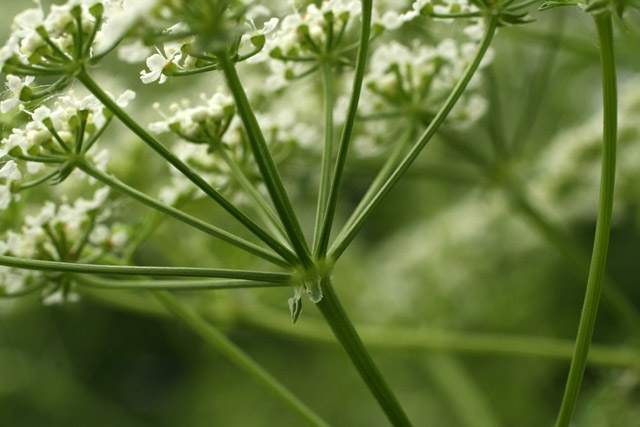 Poison hemlock (Conium maculatum) umbel, showing small simple involucre. June 7, 2008, Columbus, OH. By contrast the
involucre of Queen Anne's lace is large and pinnately branched.
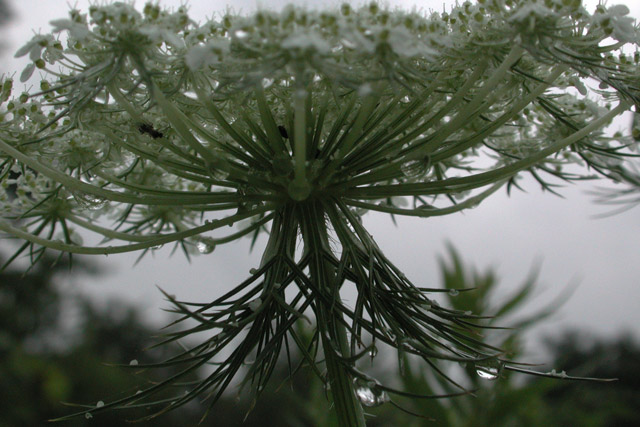 Queen Anne's lace (Daucus carota) umbel, showing elaborate involucre. Stages Pond State Nature Preserve, Pickaway County, OH, July 26, 2003. The stem is another useful identification feature. Poison hemlock is glabrous (hairless) and has purple spots on the stem. (The specific epithet --maculatum --means "spotted"). Moreover, the poison hemlock stem is glaucous. Birders might know a powdery-white northern bird called a glaucous gull. "Glaucous" is also a botanical term describing a surface with a white powdery bloom that can be rubbed off with your fingers. Poison hemlock, Conium maculatum demonstrates this property well. Here's a pair of pictures before and after rubbing the stem. 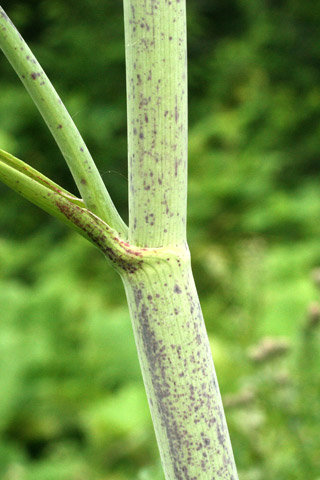 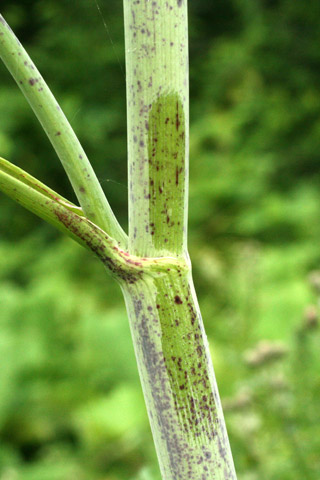 Poison hemlock stem is glaucous! Columbus OH, June 7, 2008. The stem of Queen
Anne's lace is pubescent with stiff erect hairs.
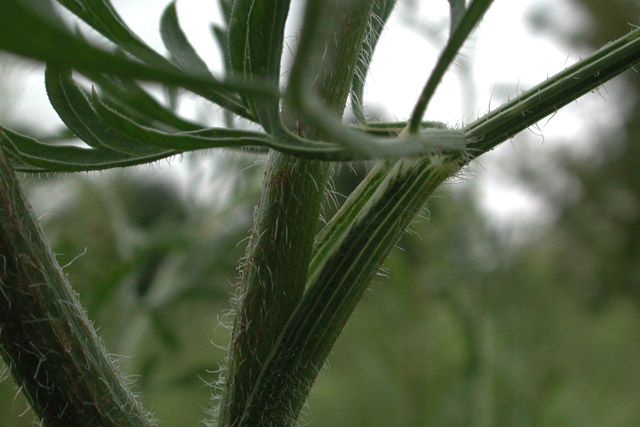 Queen Anne's lace (Daucus carota) stem and leaf base, June 7, 2008 Linear-leaved Lowland Lookalikes There are several
wetland monocots with sword-like leaves that could be mistaken for one
another: irises (Iris), bur-reed (Sparganium),
cat-tails (Typha) and sweetflag (Acorus).
Today I saw two of these growing side-by-side.
Photographing the angelica (below) was especially pleasant because of a sweet fragrance that emanated from sweetflag (Acorus sp., family Acoraceae) crushed underfoot. (The abbreviation "sp." signifies "species" as a singular noun. It is used when one doesn't know the exact species or for some other reason chooses not to give a complete scientific name. The sweetflag problem is there are evidently two species in Ohio, a recently recognized native one called A. americanus and the introduced A. calamus. According to this website they are separated by some picky little leaf veination detail that I didn't know enough to examine while in the field.) Sweetflag is by far the dominant plant here, but there are a few individuals of cat-tail (presumably Typha latifolia, family Typhaceae) scattered here and there. 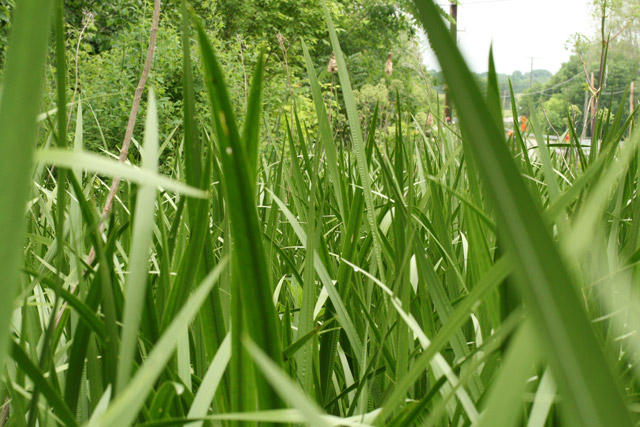 Sweetflag (Acorus sp.) with a few cat-tails (Typha latifolia), Home Road, Columbus, OH. June 7, 2008. Besides applying the
"smell
test," sweetflag leaves can be differentiated from those of
cat-tail by being bright pure-green, while the cat-tail has a
slight bluish cast. The sweetflag leaf has a stout raised midvein that
cat-tail lacks.
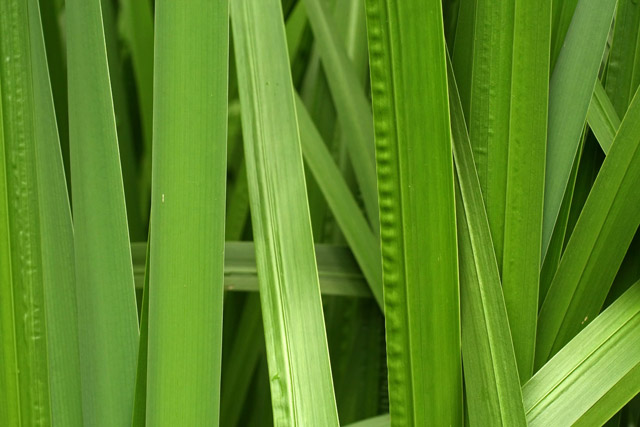 Linear-leaved lowland look-alikesTypha latifolia on the left and sweetflag (Acorus sp.) on the right. Home Road, Columbus, June 7, 2008. 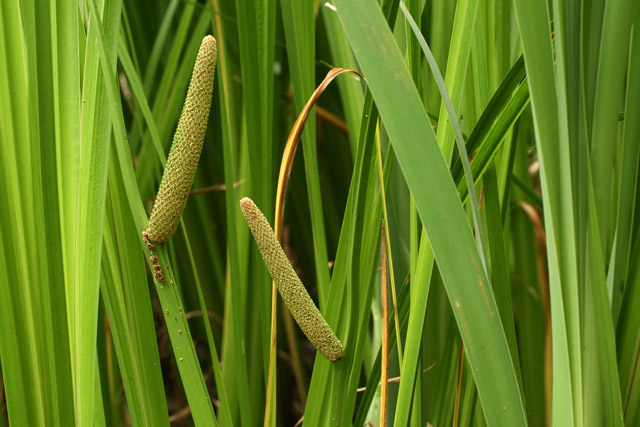 Sweetflag (Acorus sp.) flower spikes. Home Road, Columbus, June 7, 2008. Sweetflag flowers are
individually small,
stalkless, and inserted on an elongate spike-like axis termed a
"spadix." The leafy extension above the spadix is termed a "spathe."
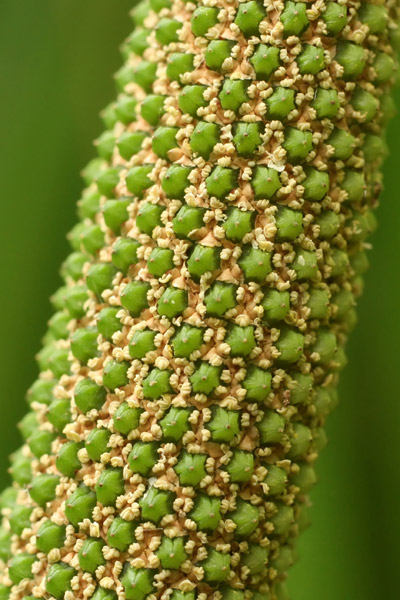 Flowers of sweetflag, Acorus sp., June 7, 2008 The genus Acorus
used to be included within the arum family, Araceae, that includes some
interesting Ohio natives such as skunk cabbage (Symplocarpus)
and Jack-in-the-pulpit (Arisaema) that have
spathe-spadix flower arrangements that are more obvious. Here's an
example of a typical arum. Coincidentally, a
friend just asked me about this one in an e-mail (Hi Dave!).
It's called green dragon, Arisaema dracontium. Does
it look like a dragon?
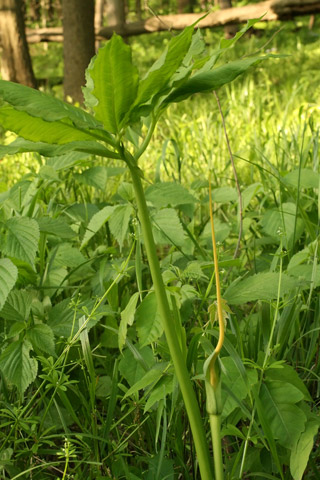 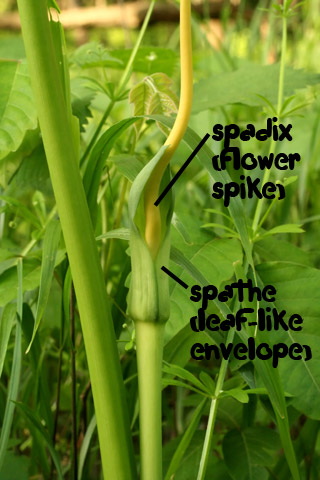 Green dragon, Arisaema dracontium (family Araceae) showing characteristic spathe-and-spadix flower arrangement. Delaware Wildlife Area, Delaware (or maybe Marion) County, OH, May 19, 2008. June 7, 2008 Fireworks in June The plant family
Apiaceae is very
distinctive. It used to be called the "Umbeliferae" because so many
members produce flowers in compound umbels. One that does so
particularly dramatically is angelica, Angelicqa atropurpurea,
a huge wetland plant the umbels of which are strikingly globe-shaped.
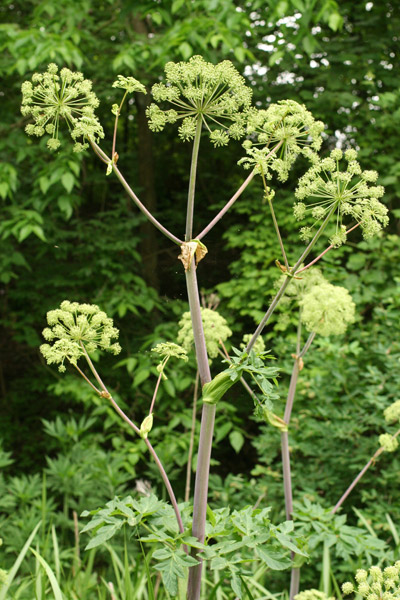 Angelica (Angelica atropurpurea, family Apiaceae), Home Rd., Columbus, OH, June 7, 2008 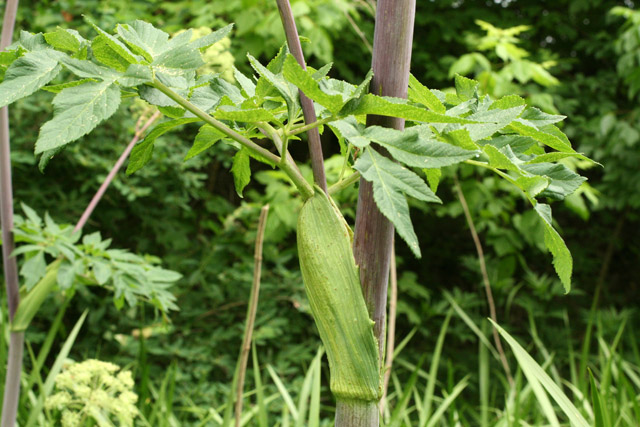 Members of the Apiaceae typically have compound leaves with an expanded base that wraps aound the stem. Angelica atropurpurea, Home Rd., Columbus, OH, June 7, 2008. Apiaceae flowers are
individually small,
with drab white, greenish, or yellow coloration. There are no flashy
colors in this family. These ants visiting angelica seemed to be both
drinking nectar and eating pollen.
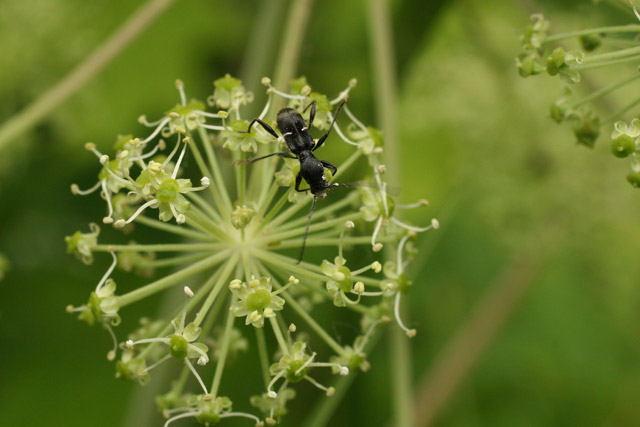 Ants on angelica,
Home Rd., Columbus, OH, June 7, 2008.
Earlier
observations ("back")
|